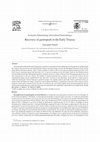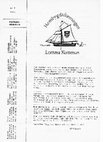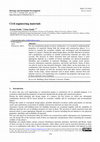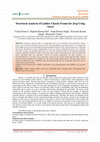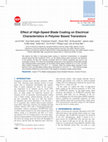Downloaded from geology.gsapubs.org on February 8, 2010
Gastropod evidence against the Early Triassic Lilliput effect
Arnaud Brayard1*, Alexander Nützel2, Daniel A. Stephen3, Kevin G. Bylund4, Jim Jenks5, and Hugo Bucher6,7
1
UMR 5561 CNRS Biogéosciences, Université de Bourgogne, 21000 Dijon, France
Bayerische Staatssammlung für Paläontologie und Geologie, Ludwig-Maximilians-University Munich, Department für Geo- und
Umweltwissenschaften, Sektion für Paläontologie, 80333 München, Germany
3
Department of Earth Science, Utah Valley University, Orem, Utah 84058, USA
4
140 South 700 East, Spanish Fork, Utah 84660, USA
5
1134 Johnson Ridge Lane, West Jordan, Utah 84084, USA
6
Paläontologisches Institut und Museum, Universität Zürich, 8006 Zürich, Switzerland
7
Department of Earth Sciences, ETH Zürich, Switzerland
2
ABSTRACT
Size reduction in the aftermath of the Permian-Triassic mass extinction event has repeatedly been described for various marine organisms, including gastropods (the Lilliput effect).
A Smithian gastropod assemblage from Utah, USA, reveals numerous large-sized specimens
of different genera as high as 70 mm, the largest ever reported from the Early Triassic. Other
gastropods reported from Serbia and Italy are also as large as 35 mm. Size frequency distributions of the studied assemblages indicate that they were not unusually small when compared
with later Mesozoic and modern faunas. The occurrence of large-sized gastropods less than
2 Ma after the Permian-Triassic mass extinction refutes the Lilliput hypothesis in this clade,
at least for the last ~75% of the Early Triassic.
INTRODUCTION
It is generally assumed that several groups of
marine organisms, including gastropods, were
affected by a pronounced size reduction in the
aftermath of the Permian-Triassic (P-T) mass
extinction (Fraiser and Bottjer, 2004; Fraiser
et al., 2005; Payne, 2005; Twitchett, 2007).
The temporary size reduction of organisms
inhabiting postcrisis biota has been termed the
Lilliput effect (Urbanek, 1993). According to
several authors (e.g., Fraiser and Bottjer, 2004;
Payne, 2005), Early Triassic gastropod faunas
are strongly dominated by microgastropods
(defined as smaller than 10 mm) and larger
sizes are rare, if not absent. Mass occurrences
of microgastropods were identified as a typical
Early Triassic biofacies (Fraiser et al., 2005). In
contrast, a considerable number of large gastropod species have been reported from the Permian as well as from the Middle and Late Triassic.
Compatible with a delayed recovery model (e.g.,
Alroy, 2008), a small body size in the aftermath
of the P-T mass extinction has been interpreted
as a consequence of potential recurrent or prolonged harsh environmental conditions including, for example, anoxia, productivity decline,
or size selection during the mass extinction
and its recovery, as well as low predation and
competitive pressure or collapse of food webs
(Fraiser and Bottjer, 2004; Fraiser et al., 2005;
Payne, 2005; Twitchett, 2001, 2007).
Only a few doubts have been raised as to
whether the Early Triassic Lilliput effect is
really such a significant phenomenon (Nützel,
2005a, 2005b; McGowan et al., 2009; Nützel
et al., 2010). Small gastropods are common in
*E-mail: arnaud.brayard@u-bourgogne.fr.
many fossil and extant assemblages. However,
an absence of very large specimens (~100 mm)
seemed to be true for the Early Triassic time
interval. Thus, most present-day gastropods are
still Lilliputians and it appears that it is more the
absence of Early Triassic Gulliver specimens
that is remarkable (Nützel et al., 2010).
Here we present a new Early Triassic gastropod assemblage from an unusual setting
within a muddy facies of the Thaynes Group of
western Utah, USA (see GSA Data Repository
Fig. DR11). It yielded numerous large (>40 mm)
specimens. Moreover, a relatively large gastropod is also reported from the Sinbad Formation
of the Thaynes Group where it interfingers with
the Moenkopi Group (Smithian, southeastern
Utah). We also studied new gastropod faunas of
the Upper Werfen Formation (Spathian, Serbia
and Italy); their size distributions indicate that
they are not unusually small. These new data as
well as brief reports of normal-sized gastropods
in the literature strongly suggest that the Lilliput
phenomenon in the aftermath of the P-T mass
extinction is equivocal.
DATA AND RESULTS
A gastropod collection from the Thaynes
Group (Smithian, Utah) and two collections from
the Upper Werfen Formation (Spathian, European Alps and adjacent areas) were measured.
The studied material from western Utah comes
1
GSA Data Repository item 2010029, location map
of the studied assemblages and a biostratigraphical
scale with occurrences of large gastropods, is available online at www.geosociety.org/pubs/ft2010.htm,
or on request from editing@geosociety.org or Documents Secretary, GSA, P.O. Box 9140, Boulder, CO
80301, USA.
from the base of the Thaynes Group (Brayard
et al., 2009a; Stephen et al., 2009). Based on a
biostratigraphical zonation by ammonoids and
conodonts, this assemblage is early and middle
Smithian in age (below and within the Meekoceras beds; Fig. DR2). Calibration of the ammonoid zonation by means of U/Pb ages indicates
that these gastropods postdate the P-T boundary
by 1–2 Ma (Galfetti et al., 2007). Large gastropods from western Utah were found in both
shale intervals and in limestone beds of the studied section (Brayard et al., 2009a; Stephen et al.,
2009). The gastropod preservation is relatively
poor, and steinkern preservation is common.
The specimens represent at least three genera and are assigned tentatively to Naticopsis,
Omphaloptycha, and “Polygyrina” sp. (Fig. 1),
which represent common taxa during this time
interval. The studied section is probably slightly
older than the basal Sinbad Formation (Goodspeed and Lucas, 2007), which has produced a
rich microgastropod fauna in southeastern Utah
(Batten and Stokes, 1986; Fraiser and Bottjer,
2004; Nützel and Schulbert, 2005).
The largest “Polygyrina” sp. specimens are
68 and 61 mm high, and several exceed a height
of 40 mm (Figs. 1C–1H). The largest specimen
of the ?Naticopsis-?Omphaloptycha group is
38 mm high and 28 mm wide (Fig. 1A); 71% are
higher than 10 mm (Fig. 2). Most of the studied
specimens are incomplete, so their original size
was considerably larger.
In addition, the discovery of a relatively large
specimen from the Sinbad Formation (southeastern Utah, Smithian; Fig. DR1) is reported
here. Tempestitic shell beds of the Sinbad
Formation yielded a diverse and abundant gastropod fauna (Batten and Stokes, 1986). With
a few exceptions, these gastropods usually do
not exceed 10 mm and have been classified as
microgastropods (e.g., Batten and Stokes, 1986;
Fraiser and Bottjer, 2004). However, a teleoconch fragment of a high-spired gastropod from
the Mexican Hat location (Nützel and Schulbert,
2005) suggests that this specimen was at least as
high as 56 mm and as wide as 20 mm (Fig. 3).
Both collections from the Upper Werfen Formation consist of two species: Natiria costata
and Werfenella rectecostata, commonly found
© 2010 Geological Society of America. For permission to copy, contact Copyright Permissions, GSA, or editing@geosociety.org.
GEOLOGY,
February
2010
Geology,
February
2010;
v. 38; no. 2; p. 147–150; doi: 10.1130/G30553.1; 4 figures; Data Repository item 2010029.
147
�Downloaded from geology.gsapubs.org on February 8, 2010
130
A
120
Sinbad
110
Omphaloptycha
+ Naticopsis
100
Frequency
90
80
Studied Thaynes assemblage
n = 472
70
60
50
40
30
20
10
0
0
4
8
12
16
20
24
28
32
36
40
B
Median = 11.4
Height (mm)
Figure 2. A: Black is height distribution of sampled specimens belonging
to?Naticopsis-?Omphaloptycha group from
the early and middle Smithian Thaynes
Group. Gray is previously published height
histogram (Fraiser and Bottjer, 2004) of
microgastropod specimens belonging to
Naticopsis-Omphalopthycha group from almost time-correlative Sinbad Limestone of
southeastern Utah. Note that height range
is different and considerably enlarged for
Thaynes Group of western Utah. B: Plot
showing median, range, extremes, and 25
and 75 percentiles of sampled specimens
of ?Naticopsis-?Omphaloptycha group from
Thaynes Group of western Utah.
Figure 1. A, B: Large-sized specimens (Université de Bourgogne Géologie Dijon, UBGD
277109 and UBGD277110, respectively) of ?Naticopsis-?Omphaloptycha group. C–H: ”Polygyrina” specimens (UBGD27111 to UBGD27116) from the early and middle Smithian (Early
Triassic) Thaynes Group of western Utah (Fig. DR1; see footnote 1). Scale bars are 10 mm.
in this area within low-diversity assemblages.
Figure 4 shows size frequency distributions for
these taxa from the two studied collections. Both
species have a median size >10 mm and a maximum size >25 mm. For both species, a maximum size of ~35 mm is reported (Frech, 1912;
Nützel, 2005a, 2005b; Nützel et al., 2010).
The literature was reviewed for particularly
large Early Triassic gastropod specimens. There
are reports from different paleolatitudes and
paleoenvironments of relatively large species of
the genus Naticopsis, such as a species >20 mm
from the Griesbachian of Oman (Wheeley and
Twitchett, 2005). Naticopsis arctica from the
Griesbachian of Greenland is also 30 mm high
and wide (Spath, 1935).
148
DISCUSSION
The abundance and predominance of small
gastropods have been identified as a global
phenomenon covering the entire Early Triassic
time interval as the consequence of prolonged
unfavorable conditions (e.g., Fraiser and Bottjer,
2004; Payne, 2005). Such size variations are
commonly interpreted as a proxy for changes
in environmental conditions during and after the
P-T mass extinction (e.g., He et al., 2007). Hautmann and Nützel (2005) pointed out that the
potential Early Triassic size reduction could have
contributed to the Lazarus effect; they reported
the first Early Triassic heterodont bivalve, Sinbadiella, an unusually small bivalve that had
escaped previous discovery. (Heterodonts had
been known from the Paleozoic and the MiddleLate Triassic to present day; the description of
Sinbadiella thus closed this Lazarus gap.)
With a shell height of ~70 mm the Smithian
gastropods from Utah studied here represent
the largest gastropods ever reported from the
Early Triassic. These and other reports of
relatively large specimens ask the question
whether the Early Triassic Lilliput effect is a
real phenomenon, at least for Smithian and
Spathian gastropods.
Rare doubts were raised as to whether the
Early Triassic Lilliput effect is really such a
significant phenomenon in gastropods (Nützel,
2005a, 2005b; Nützel et al., 2010), especially
because most modern gastropods are smaller
than 10 mm. For example, ~60% of ~2600
shelled present-day mollusk species from tropical New Caledonia have an adult size smaller
than 10 mm, and ~90% are smaller than 40 mm
(Bouchet et al., 2002). Small specimens are
common and even dominant in many fossil
gastropod assemblages. In Nützel et al. (2010),
it will be argued that it is rather the absence
or scarcity of large Early Triassic gastropod
GEOLOGY, February 2010
�Downloaded from geology.gsapubs.org on February 8, 2010
38
A
A
5
36
4
32
Frequency
Werfenella
rectecostata
Natiria costata
28
3
24
20
n = 13
16
2
n = 143
12
1
8
4
0
0
56 mm
0
4
8
12
16
20
24
28
B
32
0
4
8
12
16
20
24
28
32
B
Median = 11.4
Width (mm)
Median = 17.1
Width (mm)
Figure 4. A: Size distributions of studied specimens from Spathian Upper Werfen Formation,
belonging to species Natiria costata and Werfenella rectecostata. These specimens come
from Bletterbach Gorge at Mount Weißhorn, Italian Alps (housed in the Bayerische Staatssammlung für Paläontologie, BSPG) and from western Serbia (Humboldt Museum, Berlin,
MB; Ga.3809.1–3809.14). B: Plot showing median, range, extremes, and 25 and 75 percentiles of same studied specimens from Upper Werfen Formation.
Figure 3. Teleoconch fragment of large highspired gastropod from Sinbad Limestone
(Mexican Hat, southeastern Utah).
specimens (see also Payne, 2005) than the
presence of minute gastropods that is unusual
for this time interval. Thus, Gulliver absence
seems to be more accurate than Lilliput presence, as most living gastropods are still Lilliputians (Nützel et al., 2010).
The new data presented here corroborate the
view that the significance of Early Triassic gastropod size reduction has been overestimated.
The cited suggestions that Early Triassic gastropods are particularly small (i.e., microgastropods) are in conflict with the present reports of
relatively large or normal-sized gastropods from
Utah, Serbia, and Italy. Our large specimens
from western Utah can be considered as Gullivers compared to most other described Early Triassic gastropods. Maximum size, size frequency
distribution, and a mean size >10 mm (Fig. 2) all
suggest that this is not a microgastropod fauna
(sensu Fraiser and Bottjer, 2004; Payne, 2005;
Twitchett, 2007). Older reports of Griesbachian
GEOLOGY, February 2010
Naticopsis species that are larger than 20 mm
(Spath, 1935; Wheeley and Twitchett, 2005)
and gastropods from the Upper Werfen Formation as large as 35 mm (Frech, 1912; Neri and
Posenato, 1985; Nützel, 2005a) also reinforce
the hypothesis that the Lilliput phenomenon is
equivocal. Moreover, the size frequency distributions (Figs. 2 and 4) of these new Early Triassic gastropod assemblages suggest a body size
that is even larger than, for example, that of a
gastropod collection from the late Carnian Cassian Formation, which is very diverse and well
structured and was therefore probably not environmentally stressed (Nützel et al., 2010).
The assumption that Early Triassic gastropods
(and other organisms) were generally smaller
than during other periods therefore needs more
substantiation (see McGowan et al., 2009). The
Early Triassic diversification patterns of benthic organisms are less well documented than
for conodonts or ammonoids and have directly
influenced the classical view of a delayed recovery after the P-T mass extinction. However,
provided that the delayed character of the Early
Triassic diversification is real (Brayard et al.,
2009b), the large size of the Smithian specimens
studied here could represent an early recovery
phenomenon: an improvement of environmental
conditions could have allowed a size increase.
In this case, large taxa must have evolved from
smaller Griesbachian or Dienerian ancestors.
Sampled sections from western Utah do not
show any sign of anoxia or oxygen-deficient
levels corresponding to the gastropod intervals
pertaining to this discussion. Nevertheless, it is
currently impossible to state that these apparent
nonanoxic conditions primarily influenced and
favored large-sized gastropods, as suggested for
other faunas (Twitchett, 2007).
Another possibility is that sampling and
taphonomic biases influenced the record of gastropod size. The Early Triassic time interval is
notorious for its poor gastropod preservation
and its sparse overall fossil gastropod record
(Nützel, 2005b). Nearly half of the known
named gastropod species occur within just two
formations, the Sinbad and the Werfen (Nützel
and Schulbert, 2005). Many of these gastropod
occurrences are from well-sorted tempestitic
shell beds that contrast with the muddy facies of
the new assemblages from Utah. These kinds of
tempestitic deposits involve transport and size
sorting. At least some of the Gulliver gastropods
from western Utah could represent fully grown
specimens of species that were only present as
juveniles in the microgastropod fauna of the
Sinbad Formation. The Sinbad Formation gastropod fauna occurs in tempestites (Nützel and
Schulbert, 2005), and proximity of such deposits produces size-sorting effects. However, the
large gastropods from the Thaynes Group are
not preserved well enough to make comparisons
with species found in the neighboring Sinbad
Formation. The possibilities of ecological size
limitation and sampling or taphonomic biases
are not exclusive; both could contribute to Early
Triassic gastropod size distributions: anoxia,
abnormal salinity, turbidity, and substrate type
on the one hand, and preservation and size sorting during transportation on the other.
149
�Downloaded from geology.gsapubs.org on February 8, 2010
CONCLUSIONS
With median shell heights >10 mm and maximum sampled size up to to 70 mm, gastropods
from the Thaynes Group and the Sinbad Formation of Utah are the largest gastropods ever
reported from the Early Triassic. Other reports
also suggest that not all Early Triassic gastropods were microgastropods. The abundance of
gastropods smaller than 10 mm is not only typical of the Early Triassic; many present-day and
fossil gastropod assemblages show this small
size distribution. Based on these observations,
proposals that median sizes of Early Triassic
gastropods are generally smaller than 10 mm
and maximum sizes do not exceed 20–40 mm
can be rejected.
The large specimens reported here suggest
that the Lilliput effect is an artifact or, at least,
not as significant as previously thought. If the
Lilliput effect (or Gulliver absence) nevertheless represents a real biological phenomenon,
then the rebound of gastropod size occurred
earlier than previously assumed. In that case,
this could support the hypothesis that recovery
was rapid after the P-T mass extinction (Brayard
et al., 2009b). Numerous Lazarus taxa among
bivalves, gastropods, and ammonoids reappeared during the Smithian (e.g., Hautmann
and Nützel, 2005; Nützel, 2005b; Brayard et
al., 2007). This short time interval also shows
a major diversification of ammonoids and conodonts (Brayard et al., 2006, 2009b; Orchard,
2007). Indeed, the simultaneous reappearance
of large gastropods suggests that recovery in the
marine realm was well under way during this
time, less than 2 Ma after the mass extinction.
ACKNOWLEDGMENTS
This article is a contribution to the team “Forme,
Evolution, Diversité” of the UMR-5561 CNRS Biogéosciences (Brayard). Nützel acknowledges a research grant from the Deutsche Forschungsgemeinschaft (NU 96/6-1, 6-2). D. Stephen acknowledges
research grant support for this project from the Scholarly Activities Committee, Utah Valley University.
This work was supported by the Swiss National Science Foundation project 200020-113554 (Bucher).
We thank N. Goudemand (Zurich) for his help with
conodont determinations. We are grateful to both reviewers and G. Escarguel for their constructive comments, which helped us to improve the manuscript.
REFERENCES CITED
Alroy, J., 2008, Dynamics of origination and extinction in the marine fossil record: National Academy of Sciences Proceedings, v. 105, p. 11536–
11542, doi: 10.1073/pnas.0802597105.
Batten, R.L., and Stokes, W.L., 1986, Early Triassic gastropods from the Sinbad Member of
the Moenkopi Formation, San Rafael Swell,
Utah: American Museum Novitates, no. 2864,
p. 1–33.
Bouchet, P., Lozouet, P., Maestrati, P., and Heros,
V., 2002, Assessing the magnitude of species
richness in tropical marine environments: Exceptionally high numbers of molluscs at a New
150
Caledonia site: Linnean Society Biological
Journal, v. 75, p. 421–436, doi: 10.1046/j.1095
-8312.2002.00052.x.
Brayard, A., Bucher, H., Escarguel, G., Fluteau, F.,
Bourquin, S., and Galfetti, T., 2006, The Early
Triassic ammonoid recovery: Paleoclimatic significance of diversity gradients: Palaeogeography, Palaeoclimatology, Palaeoecology, v. 239,
p. 374–395, doi: 10.1016/j.palaeo.2006.02.003.
Brayard, A., Bucher, H., Brühwiler, T., Galfetti, T.,
Goudemand, N., Guodun, K., Escarguel, G.,
and Jenks, J., 2007, Proharpoceras Chao: A
new ammonoid lineage surviving the end-Permian mass extinction: Lethaia, v. 40, p. 175–181,
doi: 10.1111/j.1502-3931.2007.00012.x.
Brayard, A., Brühwiler, T., Bucher, H., and Jenks, J.,
2009a, Guodunites, a low-palaeolatitude and
trans-Panthalassic Smithian (Early Triassic)
ammonoid genus: Palaeontology, v. 52, p. 471–
481, doi: 10.1111/j.1475-4983.2009.00855.x.
Brayard, A., Escarguel, G., Bucher, H., Monnet, C.,
Brühwiler, T., Goudemand, N., Galfetti, T.,
and Guex, J., 2009b, Good genes and good
luck: Ammonoid diversity dynamics and the
end-Permian mass extinction: Science, v. 325,
p. 1118–1121, doi: 10.1126/science.1174638.
Fraiser, M.L., and Bottjer, D.J., 2004, The nonactualistic Early Triassic gastropod fauna: A
case study of the Lower Triassic Sinbad Limestone member: Palaios, v. 19, p. 259–275, doi:
10.1669/0883-1351(2004)019<0259:TNETGF
>2.0.CO;2.
Fraiser, M.L., Twitchett, R.J., and Bottjer, D.J., 2005,
Unique microgastropod biofacies in the Early
Triassic: Indicator of long-term biotic stress
and the pattern of biotic recovery after the endPermian mass extinction: Comptes Rendus
Palévol, v. 4, p. 475–484, doi: 10.1016/j.crpv
.2005.04.006.
Frech, F., 1912, Die Leitfossilien der Werfener
Schichten und Nachträge zur Fauna des Muschelkalkes der Cassianer und Raibler Schichten, in Hölzel, E., ed., Resultate der wissenschaftlichen Erforschung des Balatonsees:
Budapest, Wien, p. 1–96.
Galfetti, T., Bucher, H., Ovtcharova, M., Schaltegger,
U., Brayard, A., Brühwiler, T., Goudemand,
N., Weissert, H., Hochuli, P.A., Cordey, F., and
Guodun, K., 2007, Timing of the Early Triassic
carbon cycle perturbations inferred from new
U-Pb ages and ammonoid biochronozones:
Earth and Planetary Science Letters, v. 258,
p. 593–604, doi: 10.1016/j.epsl.2007.04.023.
Goodspeed, T.H., and Lucas, S.G., 2007, Stratigraphy, sedimentology, and sequence stratigraphy
of the Lower Triassic Sinbad Formation, San
Rafael Swell, Utah: New Mexico Museum of
Natural History and Science Bulletin, v. 40,
p. 91–101.
Hautmann, M., and Nützel, A., 2005, First record
of a heterodont bivalve (Mollusca) from the
Early Triassic: Palaeocological significance
and implications for the “Lazarus problem”:
Palaeontology, v. 48, p. 1131–1138, doi:
10.1111/j.1475-4983.2005.00505.x.
He, W., Shi, G.R., Feng, Q., Campi, M.J., Gu, S., Bu,
J., Peng, Y., and Meng, Y., 2007, Brachiopod
miniaturization and its possible causes during
the Permian-Triassic crisis in deep water environments, South China: Palaeogeography, Palaeoclimatology, Palaeoecology, v. 252, p. 145–
163, doi: 10.1016/j.palaeo.2006.11.040.
McGowan, A.J., Smith, A.B., and Taylor, P.D., 2009,
Faunal diversity, heterogeneity and body size in
the Early Triassic: Testing post-extinction paradigms in the Virgin Limestone of Utah, USA:
Australian Journal of Earth Sciences, v. 56,
p. 859–872, doi: 10.1080/08120090903002839.
Neri, C., and Posenato, F., 1985, New biostratigraphical data on uppermost Werfen Formation of
western Dolomites (Trento, Italy): Geologisch−
Paläontologische Mitteilungen Innsbruck, v. 14,
p. 83–107.
Nützel, A., 2005a, A new Early Triassic gastropod
genus and the recovery of gastropods from the
Permian/Triassic extinction: Acta Palaeontologica Polonica, v. 50, p. 19–24.
Nützel, A., 2005b, Recovery of gastropods in the Early
Triassic: Comptes Rendus Palevol, v. 4, p. 501–
515 (433–447), doi: 10.1016/j.crpv.2005.02.007.
Nützel, A., and Schulbert, C., 2005, Facies of two
important Early Triassic gastropod lagerstätten: Implications for diversity patterns in the
aftermath of the end-Permian mass extinction:
Facies, v. 51, p. 480–500, doi: 10.1007/s10347
-005-0074-5.
Nützel, A., Mannani, M., Senowbari-Daryan, B.,
and Yazdi, M., 2010, Gastropods from the Late
Triassic Nayband Formation (Iran), their relationships to other Tethyan faunas and remarks
on the Triassic gastropod body size problem:
Neues Jahrbuch für Geologie und Palaontologie Abhandlungen (in press).
Orchard, M.J., 2007, Conodont diversity and evolution through the latest Permian and Early Triassic upheavals: Palaeogeography, Palaeoclimatology, Palaeoecology, v. 252, p. 93–117, doi:
10.1016/j.palaeo.2006.11.037.
Payne, J.L., 2005, Evolutionary dynamics of gastropod size across the end-Permian extinction and through the Triassic recovery interval: Paleobiology, v. 31, p. 269–290, doi:
10.1666/0094-8373(2005)031[0269:EDOGSA
]2.0.CO;2.
Spath, L.F., 1935, Additions to the Eotriassic invertebrate fauna of East Greenland: Meddelelser om
Grønland, v. 98, p. 1–115.
Stephen, D.A., Bylund, K.G., Bybee, P.J., and Ream,
W.J., 2009, Ammonoid beds in the Lower Triassic Thaynes Formation of western Utah, in Tanabe, K., et al., eds, Seventh International Symposium, Cephalopods—Present and Past 2007,
Proceedings Volume: Tokyo, Tokai University
Press (in press).
Twitchett, R.J., 2001, Incompleteness of the Permian-Triassic fossil record: A consequence of
productivity decline?: Geological Journal,
v. 36, p. 341–353, doi: 10.1002/gj.883.
Twitchett, R.J., 2007, The Lillliput effect in the aftermath of the end-Permian extinction event:
Palaeogeography, Palaeoclimatology, Palaeoecology, v. 252, p. 132–144, doi: 10.1016/
j.palaeo.2006.11.038.
Urbanek, A., 1993, Biotic crises in the history of Upper Silurian graptoloids: A palaeobiological
model: Historical Biology, v. 7, p. 29–50, doi:
10.1080/10292389309380442.
Wheeley, J.R., and Twitchett, R.J., 2005, Palaeoecological significance of a new Griesbachian
(Early Triassic) gastropod assemblage from
Oman: Lethaia, v. 38, p. 37–45, doi: 10.1080/
0024116051003150.
Manuscript received 22 July 2009
Revised manuscript received 7 September 2009
Manuscript accepted 10 September 2009
Printed in USA
GEOLOGY, February 2010
�
 A. Kaim
A. Kaim Kevin Bylund
Kevin Bylund

